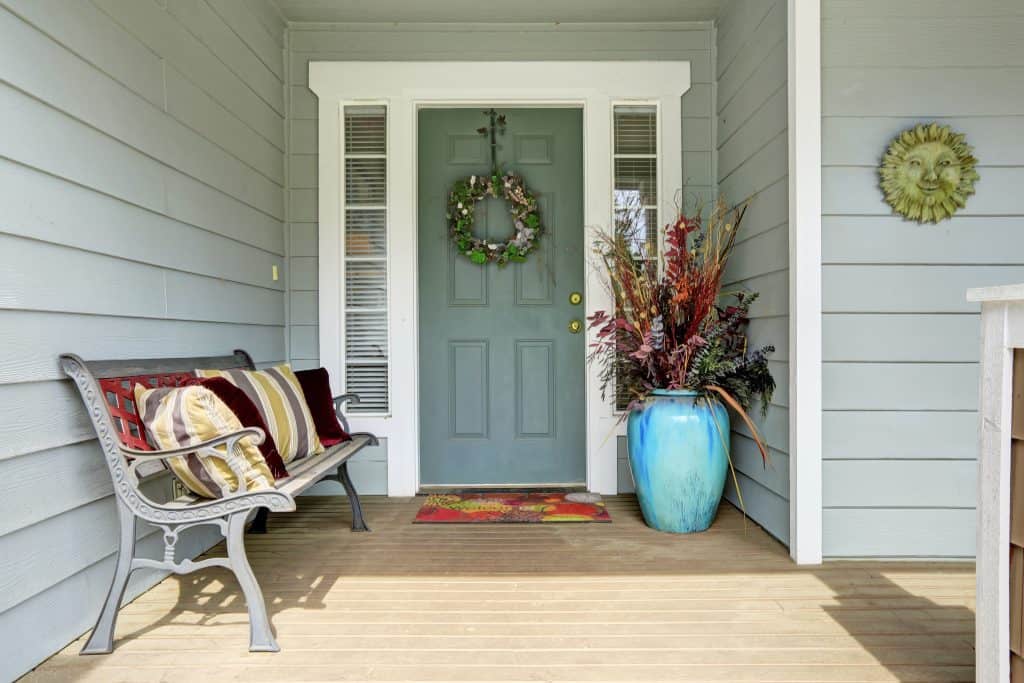The front door to your house is one of the most common entry points for intruders, and one of the most important to have secure.

Ways You Can Dramatically Improve Front Door Security
- Replace the screws in your door’s metal plate with longer three inch screws.
- Exchange your short metal plate with a longer one.
- Add the rest of the door and door hinge screws with the three longer three inch screws.
- Switch out your hollow door (if applicable) with a solid door.
- Install a lock that can only be opened from the inside.
- Add a “security lock door barricade”
- Put up a “portable door lock brace” from the inside of the door.
In this article below I go through each of these suggested protections in more detail. While these tips are all excellent ways to protect yourself and your family, it is still essential to ensure you are prepared for self-defense in case an intruder enters your home. Check out our article on the best self-defense tools here.
Back to the original point. Let’s dive into some of the most common front door security vulnerabilities.
The Most Common Front Door Security Risks Are:
Weak Door Latch Plate
In most cases, the closing latch on your door knob and the deadbolt lock, if you have one, only go between 1/2 and 1 inch into the door frame. And the wood on a typical door frame just isn’t that sturdy. There is a metal plate on your door frame that the lock goes into. But in almost every case, that metal plate is attached to the door frame with 3/4 inch screws. Which means that the plate is also only attached to that thin wooden door frame.
Weak Door Hinges
The problem we identified with the deadbolt lock also applies to the hinges. Fortunately, for exterior doors and even some interior doors, companies are starting to use at least 1 longer screw when they install the hinges, especially on exterior doors. But a lot of the screws used are still those 3/4 inch ones and they just aren’t that sturdy. In fact, people often have problems with those screws just falling out over time as they use their door, paired with the rise and fall of temperatures and humidity levels.
The Door Itself is Weak
Most exterior doors for homes are built pretty sturdy these days. But certainly not all. If your door is hollow inside, even if the shell is made of metal, it may be pretty easy to actually break through.
Weak Door Window Glass
Another problem with front doors is that a lot of them have decorative windows. That’s nice and all, but it’s far less secure than a solid door with no windows. Don’t get me wrong, those doors look great, and the glass they use is really strong. So having a window in your door isn’t the end of the world. But if you want to make your door impenetrable, I suggest going with a solid one.
Door Locks Are Easy To Pick
So now you’ve made your door impervious to blunt forces. But what if they can just unlock it?
With a lock pick or a bump key, some intruders can simply unlock your front door and walk right in. No amount of screws or plates are going to keep that door shut at that point. So what can you do?
Our 7 Ways to Dramatically Improve Your Front Door Security Are:
1. Replace The Metal Plate Screws

The easiest and cheapest solution is to replace the screws in those metal plates. Take the short screws out one at a time, and replace them with 3 inch long screws. These longer screws will go all
2. Add a Longer, Beefier Metal Plate
If you really want to make it secure, consider adding
3. Replace Door Plate & Hinge Screws With Longer Ones
This answer may seem pretty obvious after that first section. There’s no particular product that I’m going to recommend. Just replace the screws in both the door and the door frame with 3-inch long screws. That will secure the hinges firmly into the studs framing in the door, as well as into the door itself. Assuming, of course, that it’s a solid core door.
4. Replace Hollow Doors With Solid Doors
Make sure that your exterior doors are completely solid. By that I mean that they aren’t hollow at all inside. A solid wood door will hold up far better when being kicked in than any hollow core door. The only way through will be an axe, which is a good thing if a firefighter needs to break in and save your life. But there aren’t many intruders out there that will be willing to make such a scene by chopping up your front door with an axe.
5. Add A Deadbolt That Can Only Be Opened From Inside
Add a lock that can only be opened from inside. There are a lot of options here. You can add a 1-sided deadbolt that doesn’t have a keyhole on the outside. This can only be locked and unlocked from the inside. These can be tough to install yourself because you have to bore out the holes though. You can go with a chain or latch. But I really like this 3-inch door reinforcement lock by Prime Line Products. It’s easy to install and gives you quite a bit of added security, being a lock that you can only open from inside.
6. Add A Permanent Barricade
Add a permanent barricade, again that can only be removed from inside. Nightlock makes a couple of products that I really like. One, because they won’t let the door open if it
7. Use A Portable Barricade
The next option is to just use a temporary or portable barricade. There are a
So what about everyday use? You want to be able to use your front door right?
Of course you do. I don’t suggest that these block your doors all day every day. I would place these at night and when you leave the house. If you feel like you’re in an unsafe area or you’re particularly vulnerable, then keep them in during the day too.
What about when you need to leave the house? How do you get out, place these, and then how would you get back in?
It’s quite simple, I suggest that you don’t use the front door of your house for your primary exit. If you can, I would try to exit through the garage. If you take the appropriate steps, your garage can be a difficult entry point for intruders already, but a really easy entry point for you.
Putting It All Together
I don’t want you to be paranoid and think that if you don’t do these things, you’re going to get robbed, or worse. My intent here is to show you many ways that you can make your front door much more secure.
These steps will be really effective in bolstering your front door security. And even more importantly, they will be really effective in helping keep out those who may wish you harm. If you’re concerned that someone in particular may wish you harm, then don’t wait. Take the appropriate steps to have a secure front. It could save your life.

